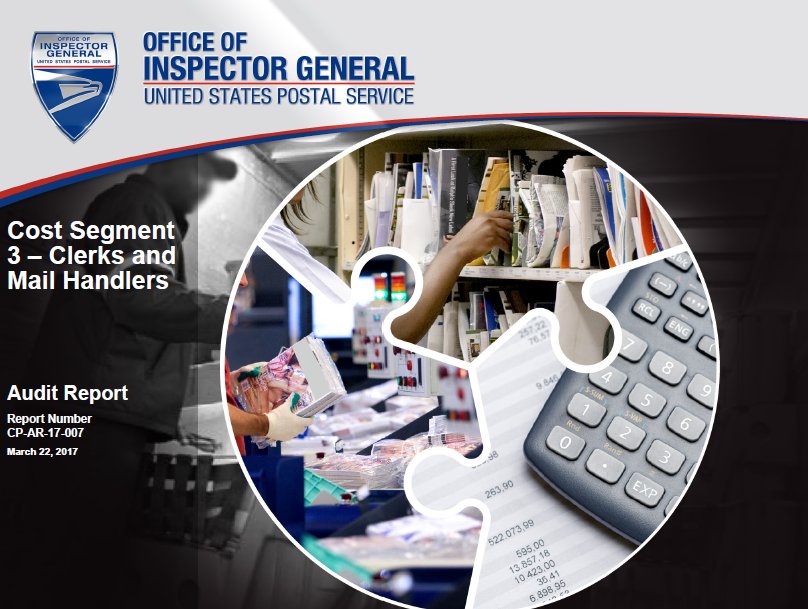
Background
The Postal Accountability and Enhancement Act of 2006 requires the U.S. Postal Service to file an Annual Compliance Report (ACR) with the Postal Regulatory Commission within 90 days of the end of each fiscal year. The report analyzes cost, revenue, rates, and quality of service for all products. Further, it reports whether revenue for each mail class and service type covers its attributable costs, which are costs directly or indirectly caused by products.
As part of the ACR, the Postal Service develops the Cost Segments and Components report. This report provides estimates of costs attributable to mail classes, subclasses, and special services by cost segment and cost component. The report contained 17 active cost segments in fiscal year (FY) 2015. The Clerks and Mail Handlers Cost Segment – known as cost segment 3 – included salaries, benefits, and related costs of clerk and mail handler work.
The Management Operating Data System (MODS) performs key functions in the cost development process for the Clerks and Mail Handlers Cost Segment. Postal Service management uses MODS workhour data to derive the totals for many of the cost categories within the cost segment.
Our objective was to assess the accuracy and completeness of mail processing costs within the Clerks and Mail Handlers Cost Segment.
What the OIG Found
The Postal Service correctly assigned expense accounts to the Clerks and Mail Handlers Cost Segment for FY 2015. However, opportunities existed to ensure mail processing cost data is accurate and complete.
The Postal Service correctly calculated mail processing costs based on the FY 2015 workhour data it extracted from the MODS in October 2015. However, discrepancies existed in workhours when comparing the FY 2015 MODS data the Postal Service extracted in October 2015 to the FY 2015 MODS data we extracted using the same methodology in October 2016. We found a total variance of over 4.6 million MODS hours between the two data reports.
Management indicated that the discrepancies were due to adjustments to MODS data after the close of FY 2015. Postal Service policy states that personnel can adjust MODS data with appropriate approval. However, current policy lacks details to control when changes to workhour data can occur or to record changes (adjustments) for tracking and verification purposes. Therefore, there was no way to determine when the adjustments were made and whether they were correct or necessary.
The MODS workhour discrepancies changed amounts for 42 mail processing cost categories reported in the FY 2015 ACR, such as the Automated Flats Sorting Machine, Automated Parcel and Bundle Sorter, and Platform cost categories. As a result, over $1 million in mail processing costs may have been misallocated among various cost categories, which would cause attributable costs within those cost categories to be distributed inaccurately to mail products and special services.
Although the discrepancies did not have a material impact on the cost data in FY 2015, the ability to change MODS data after the close of the fiscal year without a tracking mechanism increases the risk of inaccurate cost data reports. It could also lead management and the Postal Regulatory Commission to rely on inaccurate information when determining mail class and service attributable cost coverage and when setting postal prices.
In addition, the Postal Service relied on current, documented procedures and the experience and knowledge of personnel to prepare the Clerks and Mail Handlers Cost Segment. However, the procedures could be improved by including:
- Steps and timelines for obtaining source data,
- A disclosure statement explaining why MODS data used to prepare the cost segment is subject to change,
- A list of finance numbers needed to compute mail processing costs,
- The methodology for mapping MODS workhours to mail processing cost categories, and
- Specific steps on how cost adjustments are calculated.
The improvements in the procedures would likely have not prevented the discrepancies discussed previously because the current design of the MODS system does not have capabilities to track adjustments or to enable users to view data from an earlier point in time. However, well-defined, documented procedures would improve transparency into the cost development process, preserve institutional knowledge, and help ensure data quality.
What the OIG Recommended
We recommended management develop enhanced procedures or system capabilities that improve the integrity of MODS data. In the interim, we recommended management include in future ACR filings the input MODS data file and the date it was extracted. We also recommended management enhance the current documented procedures for preparing the Clerks and Mail Handlers Cost Segment.
Read Full Report
Source: USPS Office of Inspector General
